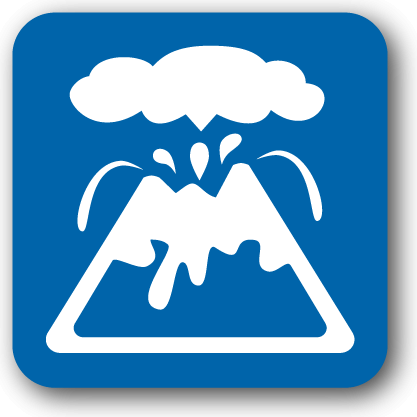Volcano Preparedness

Explosive volcanoes blast hot solid and molten rock fragments and gases into the air. As a result, ashflows can occur on all sides of a volcano and ash can fall hundreds of miles downwind. Dangerous mudflows and floods can occur in valleys leading away from volcanoes. If you live near a known volcano, active or dormant, be prepared to follow volcano safety instructions from your local emergency officials.
Mudflows
Mudflows are powerful “rivers” of mud that can move 20 to 40 mph. Hot ash or lava from a volcanic eruption can rapidly melt snow and ice at the summit of a volcano. The melt water quickly mixes with falling ash, with soil cover on lower slopes, and with debris in its path. This turbulent mixture is dangerous in stream channels and can travel more than 50 miles away from a volcano. Intense rainfall can also erode fresh volcanic deposits to form large mudflows. If you see the water level of a stream begin to rise, quickly move to high ground. If a mudflow is approaching or passes a bridge, stay away from the bridge.
Stay out of the area defined as a restricted zone by government officials. Effects of a volcanic eruption can be experienced many miles from a volcano. Mudflows and flash flooding, wildland fires, and even deadly hot ashflow can reach you even if you cannot see the volcano during an eruption. Avoid river valleys and low lying areas. Trying to watch an erupting volcano up close is a deadly idea.
Evacuation
Although it may seem safe to stay at home and wait out a volcanic eruption, if you are in a hazardous zone, doing so could be very dangerous. Stay safe. Follow authorities’ instructions and put your volcano evacuation plan into action.
Mudflows
Mudflows are powerful “rivers” of mud that can move 20 to 40 mph. Hot ash or lava from a volcanic eruption can rapidly melt snow and ice at the summit of a volcano. The melt water quickly mixes with falling ash, with soil cover on lower slopes, and with debris in its path. This turbulent mixture is dangerous in stream channels and can travel more than 50 miles away from a volcano. Intense rainfall can also erode fresh volcanic deposits to form large mudflows. If you see the water level of a stream begin to rise, quickly move to high ground. If a mudflow is approaching or passes a bridge, stay away from the bridge.
Stay out of the area defined as a restricted zone by government officials. Effects of a volcanic eruption can be experienced many miles from a volcano. Mudflows and flash flooding, wildland fires, and even deadly hot ashflow can reach you even if you cannot see the volcano during an eruption. Avoid river valleys and low lying areas. Trying to watch an erupting volcano up close is a deadly idea.
Evacuation
Although it may seem safe to stay at home and wait out a volcanic eruption, if you are in a hazardous zone, doing so could be very dangerous. Stay safe. Follow authorities’ instructions and put your volcano evacuation plan into action.
- zaf1d454db79f5f549c707224836dba3a8.jpg